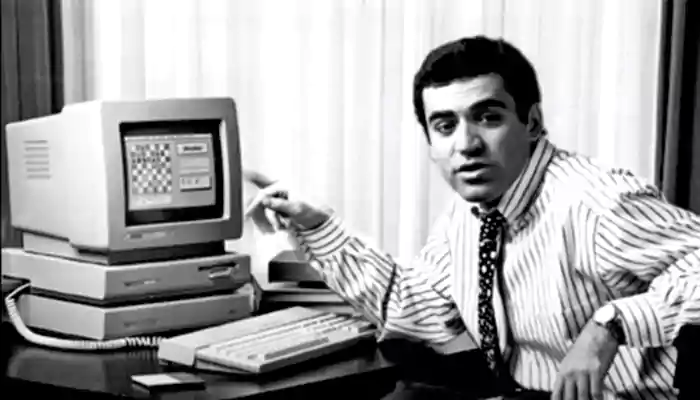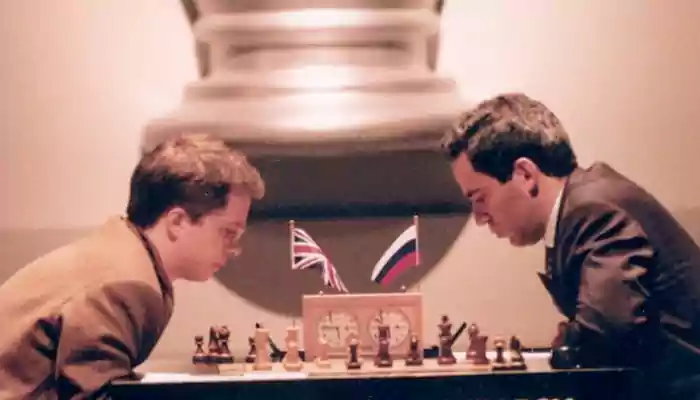Oct. 21: Kasparov's Triumph Over Short in the Chess Skirmish of '93

Aerial battle or chessboard duel? On this day in 1993, Gary Kasparov and Nigel Short redefine competition in an epic showdown.
On October 21, 1993, as the world went about its usual business, two intellectual titans embarked on a daring journey that would etch their names in the annals of chess history. A unique, high-stakes chess match was about to commence, but this battle wasn't confined to the traditional 64 squares of the chessboard. Instead, it unfolded in the skies of London, where Gary Kasparov, the reigning World Chess Champion, and Nigel Short, a brilliant challenger, took the game to new heights.
Chess in the sky
The concept of playing chess at an altitude of 500 feet seemed preposterous. Yet the audacious idea was more than a flight of fancy. The grandmaster duo planned to execute a chess match in a helicopter hovering over London. This was not just any game; it was a strategic battle of wits combined with the thrill of defying gravity.Kasparov, the chess king

Credit: @tross04401
Gary Kasparov, the Soviet-born chess prodigy, had already achieved legendary status in the chess world. Known for his fiercely competitive spirit and tactical brilliance, he has held the title of World Chess Champion since 1985. Kasparov was a chess virtuoso, and his game mastery made him the man to beat.
Nigel Short: The challenger's gambit
Opposite Kasparov stood Nigel Short, a British grandmaster and a formidable challenger. Short was known for his dynamic and creative style of play, making him a worthy contender to dethrone Kasparov. The chess world awaited the showdown, which promised a clash of contrasting chess philosophies.From skies to checkmates
As the helicopter soared above London's iconic skyline, the players were seated with chessboards on their laps. Each move made in the game mirrored the helicopter's movements, creating a unique blend of chess strategy and aerobatics. The setting was unconventional, but the stakes were genuine. Kasparov's title was on the line, and Short was determined to seize this once-in-a-lifetime opportunity.The challenge of the elements
Playing chess in the controlled turbulence of a helicopter was a chess match like no other. The wind currents could subtly alter the course of a piece, and concentration was a tightrope walk. It was a game of adapting to unforeseen circumstances, and both Kasparov and Short embraced the challenge.The chess skirmish unfolds
The chess match in the sky was a clash of strategies and nerves. Kasparov, renowned for his precise calculations, seemed unfazed by the aerial chaos. Meanwhile, Short's tactical flair shone as he sought unconventional ways to challenge the champion. The battle was not just about checkmates; a psychological tug-of-war played out with every piece.

Credit: @JustChessMini
The aerial endgame
As the helicopter circled over the River Thames, the game climaxed. Nigel Short, battling valiantly, found himself cornered by Kasparov. With a strategic brilliance that defied the turbulence, Kasparov executed a series of moves that culminated in a checkmate. The crowd on the ground erupted in cheers as Kasparov claimed victory, retaining his title as World Chess Champion.Chess history rewritten
The iconic match in the skies left an indelible mark on the history of chess. It showcased the limitless possibilities of the game, emphasising that true champions could adapt to any circumstance. Kasparov's triumph and Short's daring challenge became a source of inspiration for chess enthusiasts around the world.A skyward triumph
On this day in 1993, a chess match defied conventions and soared to new heights. Kasparov's victory in the skies of London remains a testament to human ingenuity and the unwavering spirit of competition. It was a day when checkmates danced in the wind, and chess, once again, proved itself as a game of infinite possibilities.As we reflect on this extraordinary aerial battle, we are reminded that the spirit of competition knows no boundaries. Whether on solid ground or in the skies, the quest for excellence continues, redefining the limits of what is possible in chess and beyond.












